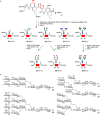Natural Glycoforms of Human Interleukin 6 Show Atypical Plasma Clearance
- PMID: 33756033
- PMCID: PMC8251587
- DOI: 10.1002/anie.202101496
Natural Glycoforms of Human Interleukin 6 Show Atypical Plasma Clearance
Abstract
A library of glycoforms of human interleukin 6 (IL-6) comprising complex and mannosidic N-glycans was generated by semisynthesis. The three segments were connected by sequential native chemical ligation followed by two-step refolding. The central glycopeptide segments were assembled by pseudoproline-assisted Lansbury aspartylation and subsequent enzymatic elongation of complex N-glycans. Nine IL-6 glycoforms were synthesized, seven of which were evaluated for in vivo plasma clearance in rats and compared to non-glycosylated recombinant IL-6 from E. coli. Each IL-6 glycoform was tested in three animals and reproducibly showed individual serum clearances depending on the structure of the N-glycan. The clearance rates were atypical, since the 2,6-sialylated glycoforms of IL-6 cleared faster than the corresponding asialo IL-6 with terminal galactoses. Compared to non-glycosylated IL-6 the plasma clearance of IL-6 glycoforms was delayed in the presence of larger and multibranched N-glycans in most cases.
Keywords: glycopeptides; glycoproteins; native chemical ligation; oligosaccharides; serum clearance.
© 2021 The Authors. Angewandte Chemie International Edition published by Wiley-VCH GmbH.
Conflict of interest statement
The authors declare no conflict of interest.
Figures







Similar articles
-
Chemical and Enzymatic Synthesis of Sialylated Glycoforms of Human Erythropoietin.Angew Chem Int Ed Engl. 2021 Dec 1;60(49):25922-25932. doi: 10.1002/anie.202110013. Epub 2021 Nov 2. Angew Chem Int Ed Engl. 2021. PMID: 34523784 Free PMC article.
-
Semisynthesis of biologically active glycoforms of the human cytokine interleukin 6.Angew Chem Int Ed Engl. 2014 Nov 3;53(45):12125-31. doi: 10.1002/anie.201407160. Epub 2014 Sep 22. Angew Chem Int Ed Engl. 2014. PMID: 25243720
-
Comparative glycoproteomics of N-linked complex-type glycoforms containing sialic acid in human serum.Anal Chem. 2005 Nov 15;77(22):7225-31. doi: 10.1021/ac050554q. Anal Chem. 2005. PMID: 16285669
-
Mass spectrometry for protein sialoglycosylation.Mass Spectrom Rev. 2018 Sep;37(5):652-680. doi: 10.1002/mas.21555. Epub 2017 Dec 11. Mass Spectrom Rev. 2018. PMID: 29228471 Review.
-
Glycoproteomics: A Balance between High-Throughput and In-Depth Analysis.Trends Biotechnol. 2017 Jul;35(7):598-609. doi: 10.1016/j.tibtech.2017.04.010. Epub 2017 May 17. Trends Biotechnol. 2017. PMID: 28527536 Review.
Cited by
-
Hypoglycemic Activity of Rice Resistant-Starch Metabolites: A Mechanistic Network Pharmacology and In Vitro Approach.Metabolites. 2024 Apr 15;14(4):224. doi: 10.3390/metabo14040224. Metabolites. 2024. PMID: 38668351 Free PMC article.
-
Implications of glycosylation for the development of selected cytokines and their derivatives for medical use.Biotechnol Adv. 2024 Dec;77:108467. doi: 10.1016/j.biotechadv.2024.108467. Epub 2024 Oct 22. Biotechnol Adv. 2024. PMID: 39447666 Free PMC article. Review.
-
Molecular cloning, characterization and gene expression analysis of twelve interleukins in obscure puffer Takifugu obscurus.Fish Shellfish Immunol Rep. 2023 Jun 21;5:100103. doi: 10.1016/j.fsirep.2023.100103. eCollection 2023 Dec 15. Fish Shellfish Immunol Rep. 2023. PMID: 37388236 Free PMC article.
-
Endosomes as Signaling Platforms for IL-6 Family Cytokine Receptors.Front Cell Dev Biol. 2021 Jun 1;9:688314. doi: 10.3389/fcell.2021.688314. eCollection 2021. Front Cell Dev Biol. 2021. PMID: 34141712 Free PMC article. Review.
-
IL-6 Signaling in Immunopathology: From Basic Biology to Selective Therapeutic Intervention.Immunotargets Ther. 2025 Jul 5;14:681-695. doi: 10.2147/ITT.S485684. eCollection 2025. Immunotargets Ther. 2025. PMID: 40636466 Free PMC article. Review.
References
-
- Wolf J., Rose-John S., Garbers C., Cytokine 2014, 70, 11–20. - PubMed
-
- Parekh R. B., Dwek R. A., Rademacher T. W., Opdenakker G., Van Damme J., Eur. J. Biochem. 1992, 203, 135–141. - PubMed
-
- Unverzagt C., Kajihara Y., Chem. Soc. Rev. 2013, 42, 4408–4420. - PubMed
-
- Reif A., Siebenhaar S., Tröster A., Schmälzlein M., Lechner C., Velisetty P., Gottwald K., Pöhner C., Boos I., Schubert V., Rose-John S., Unverzagt C., Angew. Chem. Int. Ed. 2014, 53, 12125–12131; - PubMed
- Angew. Chem. 2014, 126, 12321–12327.
Publication types
MeSH terms
Substances
LinkOut - more resources
Full Text Sources
Other Literature Sources

